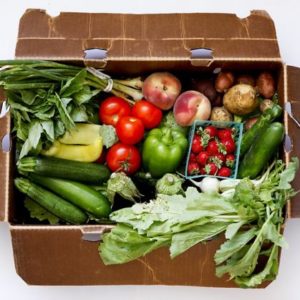Eating Tips for The Homebound Vegan

By Lauren Capano, VRG Dietetic Intern
If you ever find yourself in the position of being homebound – unable to leave the house due to illness, the inability to drive, or some other reason – it is still entirely possible to maintain a nutritionally balanced vegan lifestyle. I’ve been there; put on bedrest and unable to drive for an entire month post-surgery. After some internet sleuthing, I found that it’s not necessary to leave my bed to get my preferred veggie options to my house, even if I could! There are so many meal kit, grocery, and food delivery service programs that allow one to leap effortlessly over the boundary of getting food into the house. Below are just a few of these options – but make sure to look into which programs work best for you depending on your location, budget, skills, and taste.
CSA Programs – Community supported agriculture, popularly known as “farm share” programs, offer subscriptions or memberships for consumers to receive regular (usually weekly) deliveries of locally-grown, fresh farm products during the harvest system. These programs are usually offered by a single farmer or group of farmers and are based on a partial or total advance payment of the subscription or membership fee. Websites such as localharvest.org, usda.gov, and greenpeople.org can help to connect you to CSA’s in your area. Be aware that not all CSA’s deliver depending on the particular farms involved and your location. Delivery Options – Grocery shopping can now be done entirely from the comfort of your own home and many of these programs offer same day delivery! AmazonFresh offers prime members in major cities a wide selection of fresh produce, grocery items, and meal kits, as well as Whole Foods 365 brand products, with organic and same day delivery options. Thrive Market is a membership-based program that offers non-GMO, organic food, home and beauty products at wholesale prices. Each membership also sponsors a free membership for a low-income family in an effort to bring people into more food-accessible communities. Fresh Direct is an exclusively East-coast delivery program that partners with local farms to bring food to customers through a short supply chain – straight from the farm to your door. Instacart allows customers to order fresh food and groceries from their affiliated stores such as Wegmans, Fairway, Aldi, Costco, and more, with same day delivery. Brandless is a budget company that operates on a membership system and supplies non-GMO as well as organic grocery products, most for as low as for $3. These are just a few of the many grocery-delivery services available across the contiguous US, and since not all of them are offered everywhere it is best to do your own research to find which program works best for you.
Meal Delivery Services – Meal delivery services have taken the country by storm – catering to busy people who want to take the guess work out of the kitchen while still flexing their culinary muscles. You can set preferences based on taste, dietary restrictions, skill level, number of persons, and frequency of delivery. There are all-vegan companies such as Veestro, Food Nerd, Mama Sezz, Veg Ready, Purple Carrot, and 22 Days Nutrition. Other companies may not be entirely vegan, but have a wide selection of vegan and vegetarian options such as Healthy Chef Creations, Green Chef, Hello Fresh, Peach Dish, and many more.
Restaurant Delivery and Takeout – Many of your favorite restaurants with vegan and vegetarian options offer delivery on their own, but you can also get your favorite vegan food delivered through companies such as Uber Eats, Postmates, GrubHub, Door Dash, and more depending on your location in the US.
Once the food is home, the homebound person would do well to keep in mind some of these tips for food storage and preservation to minimize spoilage, waste, and the need to re-employ one of these delivery options again. This is a skill that will take you far beyond your period of bedrest and will continue to save you money, prevent waste, and maximize your food and pantry’s potential.
Order what you need – the easiest way to prevent waste is to not order more than you and your family can eat before it goes bad. This may take some trial and error but with experience you will become more aware of your needs and intake.
First In First Out – eat your food in the order that you bring it in – meaning the older food gets eaten first!
Store your produce appropriately – store fruits and vegetables separately to prevent early ripening of the vegetables due to ethylene gas produced by fruit, store your vegetables in breathable or perforated bags, and don’t wash your produce until you’re ready to use it as dampness encourages bacteria growth.
Shelf-stable grocery and freezer items are your friends – canned, boxed, and frozen food lasts longer than fresh. Liven up these items with fresh herbs and vegetables to improve the eating experience
For information about other vegetarian/vegan mail-order sources, see https://www.vrg.org/links/products.htm#retailer
The contents of this posting, our website, and our other publications, including Vegetarian Journal, are not intended to provide personal medical advice. Medical advice should be obtained from a qualified health professional. We often depend on product and ingredient information from company statements. It is impossible to be 100% sure about a statement, info can change, people have different views, and mistakes can be made. Please use your best judgment about whether a product is suitable for you. To be sure, do further research or confirmation on your own.
